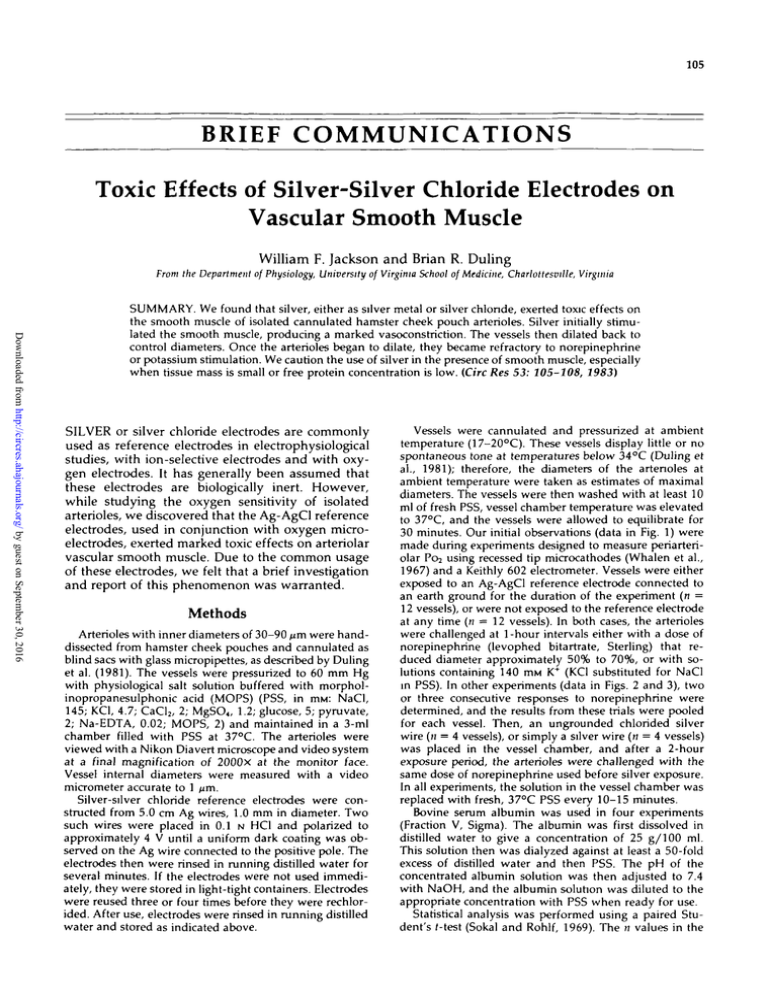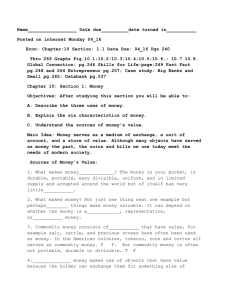
105
BRIEF COMMUNICATIONS
Toxic Effects of Silver-Silver Chloride Electrodes on
Vascular Smooth Muscle
William F. Jackson and Brian R. Duling
From the Department of Physiology, University of Virginia School of Medicine, Charlottesville, Virginia
Downloaded from http://circres.ahajournals.org/ by guest on September 30, 2016
SUMMARY. We found that silver, either as silver metal or silver chloride, exerted toxic effects on
the smooth muscle of isolated cannulated hamster cheek pouch arterioles. Silver initially stimulated the smooth muscle, producing a marked vasoconstriction. The vessels then dilated back to
control diameters. Once the arterioles began to dilate, they became refractory to norepinephrine
or potassium stimulation. We caution the use of silver in the presence of smooth muscle, especially
when tissue mass is small or free protein concentration is low. (Che Res 53: 105-108, 1983)
SILVER or silver chloride electrodes are commonly
used as reference electrodes in electrophysiological
studies, with ion-selective electrodes and with oxygen electrodes. It has generally been assumed that
these electrodes are biologically inert. However,
while studying the oxygen sensitivity of isolated
arterioles, we discovered that the Ag-AgCl reference
electrodes, used in conjunction with oxygen microelectrodes, exerted marked toxic effects on arteriolar
vascular smooth muscle. Due to the common usage
of these electrodes, we felt that a brief investigation
and report of this phenomenon was warranted.
Methods
Arterioles with inner diameters of 30-90 /zm were handdissected from hamster cheek pouches and cannulated as
blind sacs with glass micropipettes, as described by Duling
et al. (1981). The vessels were pressurized to 60 mm Hg
with physiological salt solution buffered with morpholinopropanesulphonic acid (MOPS) (PSS, in ITIM: NaCl,
145; KC1, 4.7; CaCl2, 2; MgSO4, 1.2; glucose, 5; pyruvate,
2; Na-EDTA, 0.02; MOPS, 2) and maintained in a 3-ml
chamber filled with PSS at 37°C. The arterioles were
viewed with a Nikon Diavert microscope and video system
at a final magnification of 2000X at the monitor face.
Vessel internal diameters were measured with a video
micrometer accurate to 1 ^m.
Silver-silver chloride reference electrodes were constructed from 5.0 cm Ag wires, 1.0 mm in diameter. Two
such wires were placed in 0.1 N HC1 and polarized to
approximately 4 V until a uniform dark coating was observed on the Ag wire connected to the positive pole. The
electrodes then were rinsed in running distilled water for
several minutes. If the electrodes were not used immediately, they were stored in light-tight containers. Electrodes
were reused three or four times before they were rechlorided. After use, electrodes were rinsed in running distilled
water and stored as indicated above.
Vessels were cannulated and pressurized at ambient
temperature (17-20°C). These vessels display little or no
spontaneous tone at temperatures below 34°C (Duling et
al., 1981); therefore, the diameters of the artenoles at
ambient temperature were taken as estimates of maximal
diameters. The vessels were then washed with at least 10
ml of fresh PSS, vessel chamber temperature was elevated
to 37°C, and the vessels were allowed to equilibrate for
30 minutes. Our initial observations (data in Fig. 1) were
made during experiments designed to measure periarteriolar P02 using recessed tip microcathodes (Whalen et al.,
1967) and a Keithly 602 electrometer. Vessels were either
exposed to an Ag-AgCl reference electrode connected to
an earth ground for the duration of the experiment (n =
12 vessels), or were not exposed to the reference electrode
at any time (n = 12 vessels). In both cases, the arterioles
were challenged at 1-hour intervals either with a dose of
norepinephrine (levophed bitartrate, Sterling) that reduced diameter approximately 50% to 70%, or with solutions containing 140 mM K+ (KC1 substituted for NaCl
in PSS). In other experiments (data in Figs. 2 and 3), two
or three consecutive responses to norepinephrine were
determined, and the results from these trials were pooled
for each vessel. Then, an ungrounded chlorided silver
wire (H = 4 vessels), or simply a silver wire (n = 4 vessels)
was placed in the vessel chamber, and after a 2-hour
exposure period, the arterioles were challenged with the
same dose of norepinephrine used before silver exposure.
In all experiments, the solution in the vessel chamber was
replaced with fresh, 37°C PSS every 10-15 minutes.
Bovine serum albumin was used in four experiments
(Fraction V, Sigma). The albumin was first dissolved in
distilled water to give a concentration of 25 g/100 ml.
This solution then was dialyzed against at least a 50-fold
excess of distilled water and then PSS. The pH of the
concentrated albumin solution was then adjusted to 7.4
with NaOH, and the albumin solution was diluted to the
appropriate concentration with PSS when ready for use.
Statistical analysis was performed using a paired Student's /-test (Sokal and Rohlf, 1969). The n values in the
Circulation Research/Vo/. 53, No. 1, July 1983
106
figure legends refer to the number of vessels per mean.
Thus, a total of 36 arterioles were studied in the present
investigation. All statistical comparisons were made at the
a = 0.05 level.
60
1
Results
3"
Downloaded from http://circres.ahajournals.org/ by guest on September 30, 2016
We found that, whenever silver was present in
the vessel chamber, either as silver or silver-silver
chloride, the arterioles lost all responsiveness to
vasoactive stimuli (0.59-15 /IM norepinephrine or
140 mM K+) within 2 hour after cannulation (Figs. 1
and 2). This observation did not depend on the
presence or absence of an oxygen electrode in the
vessel chamber, connection of the electrode to an
earth ground, or whether or not the silver had been
previously chlorided (Fig. 2). In one experiment, a
freshly chlorided electrode was preequilibrated in
50 ml of 37°C PSS for approximately 4 hours and
then used. Similar results to those in Figure 2 were
obtained. Also, we found that new electrodes and
electrodes that had been used up to 4 times produced similar effects. Thus, it would appear that the
observed effects depended on the physical presence
of silver in the vessel chamber and not on the age
or past history of the electrode.
Vessels not exposed to silver remained responsive
to vasoactive stimuli (0.59 fiM norepinephrine or less,
or 140 mM K+) for at least 2 hours in vitro (Fig. 1),
60
(70)
J- 40
E
5
(70
20
Q
Not Exposed
to
Exposed
to
AgCI Electrode
AgCI Electrode
FIGURE 1. Reactivity of isolated arterioles to vasoconstrictor stimuli
after 2 hours of equilibration with or without Ag-AgCl reference
electrode. Data are presented as mean diameters ± SE(n = 12 vessels
per mean, 24 vessels total). Open bars represent the mean diameter
of arterioles after 2 hours in vitro. Stippled bars represent the mean
diameters of arterioles exposed to vasoactive stimuli (0.59 ^M or less
norepinephrine for arterioles not exposed to silver and 0.59 to 15 M«
norepinephrine or 140 mM K+ for vessels exposed to silver). Solid bars
represent the mean paired differences in diameters. The numbers in
parentheses indicate the mean maximum diameter of the arterioles in
each group. + = significantly greater than zero (a = 0.05). See text
for more information.
40
20
Pre
Post
AgCI Wire
Pre
Post
Ag Wire
Pre
Po»t
P
Ag Wire
Albumin
FIGURE 2. Comparison of the reactivities of arterioles before and after
2 hours of exposure to AgCI wires or Ag wires, and Ag wires in the
presence of albumin. Data are presented as mean diameters ± SE (n
— 4 vessels per mean, 12 vessels total). Open bars represent mean
diameters before challenge with norepinephnne. Stippled bars represent mean diameters after challenge with 0.59 IIM norepinephnne.
Solid bars represent the mean paired differences in diameters. "Pre"
denotes response prior to silver exposure. 'Post" denotes response
after 2 hours of exposure to silver. Numbers in parentheses indicate
the mean maximum diameter of the artenoles in each group. + =
significantly greater than zero (a = 0.05). See text for more information.
and most vessels not exposed to silver retained
reactivity for 4 hours or more.
The response of arterioles to silver was consistently biphasic, although the timecourse of the
events were highly variable. A typical record is
shown in Figure 3. Within 4 to 15 minutes after
silver was introduced into the bath, the arterioles
would constrict to approximately 30% of their preexposure diameters. The vessels would then remain
constricted for 8 to 60 minutes after which time they
would dilate to their approximate pre-exposure diameter. Once the vessels began to dilate, they were
refractory to vasoactive stimuli for at least 4 hours,
even after the source of silver had been removed
from the vessel chamber and the arterioles had been
vigorously washed with fresh PSS. In two of the
eight vessels exposed to silver or chlorided silver
wires, removal of the silver, as soon as vessel constriction could be detected, reversed the effects.
We tested to see if the vasodilator adenosine (167
IIM) or Ca++-free salt solutions would relax the arterioles while it was in the silver constricted state,
and we found that both treatments were without
effect.
Because the toxic species of silver compounds has
been attributed to free silver ions (Cooper and Jolly,
1970; Klein, 1978; Petering, 1976), and because the
affinity of Ag+ for protein is very high (Klein, 1978;
Petering, 1976), we tested to see whether protein in
the PSS in the vessel chamber would protect against
the toxic actions of silver.
We found that, in the four vessels tested, 0.5-1.5
g/100 ml albumin eliminated the effects of silver on
arterioles for at least 2 hours (Fig. 2). In additional
Jackson and Duling/Silver and Smooth Muscle
IOOT
£50
E
o
0J
4min
FIGURE 3. Biphasic response of an arteriole to silver. This is a tracing
from a diameter record of an arteriole exposed to a chloridcd silver
wire. NE = Challenge vessel with 0.59 /IM norepinephrine. W = wash
with 10 ml PSS. IN = place Ag-AgCl wire into vessel chamber.
Downloaded from http://circres.ahajournals.org/ by guest on September 30, 2016
experiments, 0.1 g/100 ml albumin was used, and
we found that this concentration of protein did not
eliminate the constrictor action of silver. However,
the arterioles remained responsive to norepinephrine during the 2-hour exposure, in spite of being
constricted. Thus, 0.1 g/100 ml albumin in the bath
solution protected the vessel from the effects of
silver but did not eliminate the effects entirely.
We also attempted to isolate electrodes from vessels by a 3.5-cm salt bridge filled with PSS, as
suggested by Marshall (1959). This increased the
time of onset of the stimulatory phase to 30-60
minutes but did not eliminate the effect.
Platinum wire electrodes were also tested in three
vessels, and we found no deleterious effects, in
terms of vessel constriction and norepinephrine reactivity, after up to 4 hours of exposure.
Discussion
Dilute solutions of a variety of silver compounds
have strong bacteriocidal properties (Klein, 1978)
and have been shown to inhibit enzyme activity in
vitro (Klein, 1978; Petering, 1976). Also, Fisher et al.
(1957) have shown that silver or silver-silver chloride electrodes implanted in cat brains cause pathological changes in tissue surrounding the electrodes.
These actions of silver compounds have been attributed to the free Ag+ released in solution (Cooper
and Jolly, 1970; Klein, 1978; Petering, 1976) and
interaction of this ion with sulfhydryl, amino, imidazole, phosphate or carboxyl groups of proteins
(Klein, 1978; Petering, 1976).
Because of the strong affinity of proteins and other
biological anions for Ag+, the action of Ag+ on large
multicellular organisms or systems is not apparent
until such systems are challenged with massive
doses of Ag+ (Cooper and Jolly, 1970; Klein, 1978).
Small amounts of Ag+ injected into an experimental
animal will bind to plasma proteins, and the resulting free Ag+ concentrations will be essentially zero.
This is not the case with small tissues in vitro or
107
with isolated cells where the free protein concentration is small. The arterioles we studied were only
two cell layers thick, and the protein available for
binding Ag+ would have been very limited. In this
regard, it is noteworthy that protein added to the
solutions surrounding arterioles eliminated the effects of silver on the arterioles. Protein added to the
media surrounding bacteria has also been shown to
decrease the bacteriocidal action of Ag+ (Klein,
1978).
No methods for Ag+ measurement were available
to us to determine the exact silver concentrations in
our solutions. However, a very rough upper limit
may be estimated by computing the maximum Ag+
concentration consistent with the known solubility
products (Castellan, 1971). In an ideal solution containing 150 mM Cl~, based on the solubility of AgCl
in water at 37°C (21.9 /zM/liter; interpolated from
data in linke, 1958), the concentration of free Ag+
should be no greater than 5.65 nM. However, in
more complex solutions, such as the PSS used in
this study, the calculation of the expected Ag+ concentration becomes non-trivial. In 150 mM NaCl
solution at 37°C, the solubility of AgCl may be as
high as 11 jtM/liter (interpolated from data in Linke,
1958). Unfortunately, the methods used to determine this solubility measured total Ag concentration
in the solution and not Ag+ concentration. Thus, the
precise concentration of Ag+ generated in the present study can not be calculated, but is likely to be
less than 11 /iM/liter.
The pattern of response that we observed is not
unique to vascular smooth muscle. Lukanov and
Atmadjov (1979) exposed guinea pig stomach
smooth muscle to physiological salt solutions made
with water containing electrolytically produced Ag+
(total Ag concentration, 46 ^IM). They found that the
silver solutions produced biphasic responses that
were nearly identical to our findings; silver initially
stimulated the smooth muscle, and this stimulation
was followed by an apparently indefinite period of
refractoriness to stimuli which normally would have
caused the stomach muscle to contract. The precise
mechanism by which Ag+ exerts its effects on
smooth muscle is not known, but Lukanov and
Atmadjov (1979) suggested that the excitatory phase
of Ag+ action resulted from inhibition of the 'Capump' and the inhibitory phase resulted from a
drastic decrease in Ca++ permeability.
Our observations and the results of Lukanov and
Atmadjov (1979) indicate that extreme caution must
be exercised when using silver compounds in the
presence of smooth muscle. This is especially true
when tissue mass is small and the concentration of
free protein is low. In flow-through systems, or in
systems with significant tissue other than smooth
muscle silver toxicity may not be a problem. However, in systems where the only tissue present is
smooth muscle we suggest that the use of silver
compounds be avoided. If silver is to be used, protein should be added to the media surrounding the
Circulation Research/Vol. 53, No. 1, July 1983
108
smooth muscle preparations. Platinum electrodes do
not appear to affect smooth muscle and might be
substituted for silver-silver chloride electrodes
where possible.
Supported by National Institutes of Health Grants HL06337 (WFJ)
and HL13437 (BRD).
Address for reprints: Dr. William F. Jackson, Department of Physiology, University of Virginia School of Medicine, Charlottesville, Virginia 22908.
Received July 26, 1982; accepted for publication June 2, 1983.
References
Downloaded from http://circres.ahajournals.org/ by guest on September 30, 2016
Castellan GW (1971) Physical Chemistry, ed 2. Reading, AddisonWesley Publishing Company, pp 377-423
Cooper CF, Jolly WC (1970) Ecological effects of silver iodide and
other weather modification agents: A review. Water Resources
Res 6: 88-98
Duling BR, Gore RW, Dacey RG, Damon DN (1981) Method for
isolation, cannulation and in vitro study of single microvessels.
Am J Physiol 241:H108-H116
Fisher G, Sayre GP, Bickford RG (1957) Histologic changes in
cat's brain after introduction of metallic and coated wire used
in electroencephalography. Proc. Mayo Clin 32: 14-21
Klein DA (1978) Environmental Impacts of Artificial Ice Nucleating Agents. Stroudsburg, Dowden, Hutchinson and Ross Inc.,
pp 63-186
Linke, WF (1958) Solubilities of Inorganic and Metal Organic
Compounds vol 1, ed 4. Washington, D.C., American Chemical
Society, pp 59-70
Lukanov J, Atmadjov P (1979) Investigating the effect of silver
on the contractile function of smooth muscle preparation. Folia
Med (Plovdiv) 21: 11-19
Marshall WH (1959) Spreading cortical depression of Lea'o. Physiol Rev 39: 239-279
Petering HG (1976) Pharmacology and toxicology of heavy metals: silver. Pharmacol Ther 1: 127-130
Sokal RR, Rohlf FJ (1969) Biometry. New York, Freeman, pp 239242
Whalen WJ, Riley J, Nair P (1967) A microelectrode for measuring
intracellular PO2. J Appl Physiol 23: 798-801
INDEX TERMS: Arterioles • Silver-silver chloride electrodes •
Silver toxicity • Vascular smooth muscle • Vascular reactivity
Erratum
RE: Myocardial Metabolites of Ethanol (Circ. Res. 52: 479-482, 1983)
Due to a printer's error the structural formula in the legend of Figure 2 on page
480 is incorrect. It should read:
•CH 2 C-OC 2 H 5
I
O + -H
Toxic effects of silver-silver chloride electrodes on vascular smooth muscle.
W F Jackson and B R Duling
Downloaded from http://circres.ahajournals.org/ by guest on September 30, 2016
Circ Res. 1983;53:105-108
doi: 10.1161/01.RES.53.1.105
Circulation Research is published by the American Heart Association, 7272 Greenville Avenue, Dallas, TX
75231
Copyright © 1983 American Heart Association, Inc. All rights reserved.
Print ISSN: 0009-7330. Online ISSN: 1524-4571
The online version of this article, along with updated information and services, is located on
the World Wide Web at:
http://circres.ahajournals.org/content/53/1/105
Permissions: Requests for permissions to reproduce figures, tables, or portions of articles originally
published in Circulation Research can be obtained via RightsLink, a service of the Copyright Clearance
Center, not the Editorial Office. Once the online version of the published article for which permission is
being requested is located, click Request Permissions in the middle column of the Web page under Services.
Further information about this process is available in the Permissions and Rights Question and Answer
document.
Reprints: Information about reprints can be found online at:
http://www.lww.com/reprints
Subscriptions: Information about subscribing to Circulation Research is online at:
http://circres.ahajournals.org//subscriptions/




